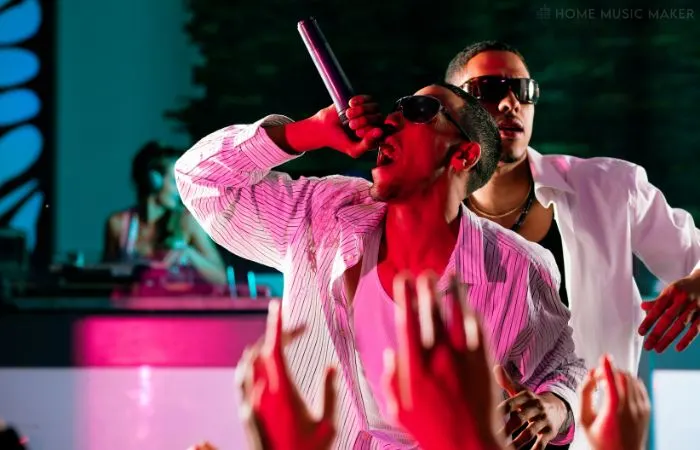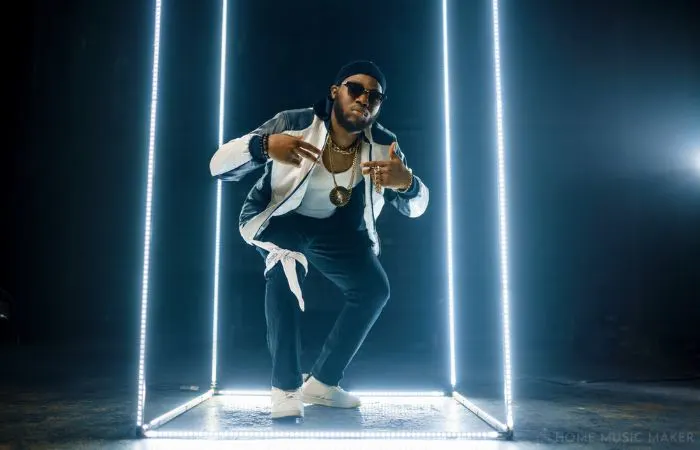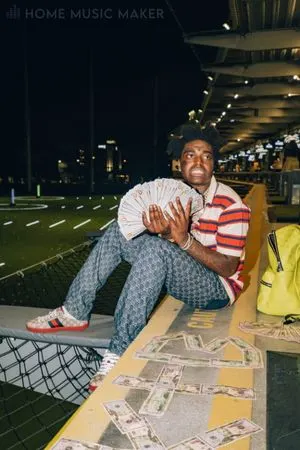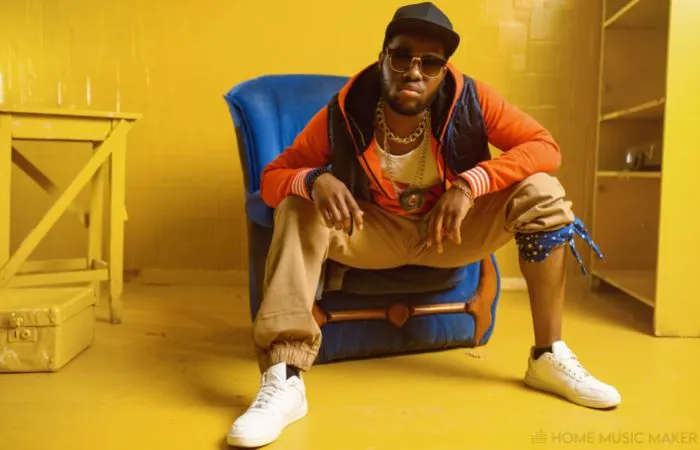KEY TAKEAWAYS:
To rap, you must write clever lyrics that utilize pronunciation and rhyme schemes to create a rhythmic flow that compliments the instrumental you are rapping over. Then it would help if you practiced until you could recite the lyrics flawlessly and finally record them with a microphone.
The Mysteries Of Rapping
If you want to learn how to rap, then this guide will help you get started.
I’ll explain rap music and how it came about before guiding you through the rhyme patterns and flow of today’s most popular rappers.
You can emulate their styles and create your rap songs.
By the end of this guide on how to rap, you’ll have everything you need to go from beginner rapper to bonafide hip hop star!

Step-By-Step Guide On Learning How To Rap
What You Need To Follow This Guide
You need determination, a pencil, and paper to follow along.
That’s it! Let’s get into it.
Step 1: Find Your Rhythm
Find a rhythm you like and start brainstorming. You can freestyle rap or stick to a specific rhyme scheme.
Step 2: Practice, Practice, Practice!
Practice makes perfect! The easiest way to rap better is to practice as much as possible.
Step 3: Study Time
Listen and study other rappers. Once you find one with the correct flow for your taste, copy what they are doing and then put your spin on it. If you have more than one rapper you like, you can mix them differently.
Step 4: Get Creative
Choose a style that fits your voice and build on it from there! Have fun with it! Hip-hop is all about experimentation and creativity.
Step 5: Branch Out
Listen to many different kinds of hip-hop (not just one) to find inspiration. Even if you want to refrain from rap in that sub-genre, it will help you.
Step 6: Niche Down
Learn what kind of audience you want to cater to. Understand everything about what draws them into an artist.
Step 7: Write Your Heart Out
Get some writing experience and practice writing fully structured songs with an intro, outro, chorus, and verse. It’s no good just being good at one of these.
Understanding The Vocab
To rap well, you need to be able to do so on the beat, which means with the same rhythm, or a complimentary rhythm, as the beat you rap over. Rhythm is essential since it dictates how fast or slow you should rap.

Writing your chorus will also help you learn how to make your song because it will teach you song structure. The chorus is the climax of the music, often repeated several times.
Rappers usually freestyle rap and rap battle each other. It’s fun and good practice for the future!
A freestyle is when you rap from the top of your head without prior practice or writing; a rap battle is when you rap competitively.
Hip-hop is a popular form of music that focuses heavily on rhyming schemes, which means the order of words and how they rhyme.
An example:
“That is a cat
And this is a bat
And if you eat too much
You will get fat.”
It has an AABA rhyme scheme.
Also, rap is usually written as 1 bar per line. A bar is a term for a measure in music. A measure is a length of time that consists of 4 beats.
Developing Your Own Style
There are so many different styles of rap that it can be challenging to figure out what style is best for you. But here are some suggestions:
1) Freestyle raps are often about things that happen in your day-to-day life. Sometimes people will freestyle about a word or phrase they hear from someone else, and other times. People will freestyle about thoughts going through their heads.
The key is going with whatever comes up in your head. Some people find it helpful to have something to work off of, like a list of rhyming words or phrases, if they’re having trouble coming up with something on their own.
2) Punchline raps are all about making clever jokes. They usually use puns, similes, metaphors, and wordplay to make jokes.
3) Battle raps are about being good enough to beat someone in a rap battle. And while anyone can improve by practicing more, there are also various ways to train oneself specifically for this type of performance art form.
4) Catchy raps typically incorporate catchy melodies and beats and upbeat rhythms. Lyrics vary widely, but most catchy songs talk about love, partying, sex, money, and bragging rights.
Listen To Other Rap Music
The lyrics are the most critical aspect of rapping, but you must also know how to rap fast. We have a whole article dedicated to this topic, so if you haven’t already, go ahead and check it out here.

Listening to other rap music and freestyle rap is a great way to improve and practice speed. Keep practicing by listening to more rap music and trying to mimic the same flow. Do this until you can recite the rap flawlessly.
Once you are comfortable, try substituting some lines with your rhymes.
You will pick up new flows, rhythms, words, and rhyme schemes along the way. Eventually, you can start participating in rap battles with friends or strangers who like rapping too. If you feel confident enough to perform in public, try entering a hip-hop battle or a talent show!
Take any opportunity to rap publicly that arises and challenge yourself as much as possible. The goal is not to always win a rap battle or meet somebody else’s expectations of you but to find ways that work for you and make progress.
You should be focused on personal improvement because, ultimately, there’s no right way to be a rapper- everybody’s different. Remember, not everyone will like your style, so go with the flow and let people decide what they think about your skill.
Learn How To Emulate Other Rappers
The best way to learn how to rap is by listening to your favorite rappers and emulating their rhyme schemes, lyrics, and flow. To better understand the structure of rap music, you should also study the history and origins of hip-hop culture.

Listen to artists frequently for inspiration. Artists like Nas, Kendrick Lamar, 2Pac, Jay-Z, Biggie Smalls, and Eminem are all great examples.
Remember that if you want to freestyle rap on stage in front of an audience, you should practice rapping fast and memorizing lyrics ahead of time. It can get nerve-wracking if you’re not used to doing it in front of people.
Learn To Rhyme
Rap is a musical form with words traditionally spoken rhythmically, with the rapper usually using rhyming lyrics or phrases.
One of the most invaluable tools for a rapper is what’s called a rhyming dictionary. It’s exactly what it sounds like and can help tremendously with learning rhymes.
Always think about what you’re saying because rap is all about the lyrics, and it’ll take a while before you learn how to rap well. Be prepared for people who say you can’t rap, and don’t let them get you down.
Also, rhymes don’t always have to be perfect (like cat and bat), but you will be fine if it sounds close enough. Furthermore, you can even intentionally mispronounce certain words to make a rhyme.
Just make sure it’s still apparent what you’re talking about, or your audience will need help to get lost.
Practice makes perfect, so keep at it until you’ve mastered the art of rhyming.
Learn About Multi-Syllable Rhyming
Now that you’ve familiarized yourself with the basics of rhyming, you need to think about how to rap better by learning more about multi-syllable rhyming.
Rap music is a lyrical art form, so learning to rhyme words with more than one syllable will help you increase your skills as an artist. The best way to start rapping better is by paying attention to the sound of the words and not just their meaning.
You can do this by freestyling or having a rap battle with another person to help you memorize some new lyrics. You’ll also want to know some good rhymes for writing lyrics or freestyling on your own because sometimes those great thoughts in your head might escape before you have time to write them down!
It is essential to know the tricks rappers use to make their lyrics more exciting and entertaining.
Freestyle rap is usually the most entertaining because it’s free-flowing and unpredictable. Still, you can also make it enjoyable by using clever rhyming schemes like AABB or AAAA. Different rhyming schemes are often determined by whether they repeat like AABA or end after two lines like AAAA.
Find Your Rapping Voice
Have you ever wondered how some people can rap so fast and sound so good? It’s because they have found their voice. They are comfortable with their rapping style, and it sounds good to them, which is what matters most.
Here are some tips on how to find your voice in rapping:
- Freestyle rap a little bit, and write down what words you use the most. Pay attention to any rhyming patterns you might have created as well. You might be surprised by what you come up with!
- Rhyme schemes can improve flow and make your lyrics more interesting.
- Put on a beat when you’re home alone and start freestyling. But first, hit the record on your phone, then set it down. Now freestyle and experiment with different tones of voice and pronunciations. Even if you think it will sound stupid, do it anyway, and eventually, you will find something that works.
Learn How To Structure A Song
The basic structure of a rap song is like this:
- Intro
- Verse 1
- Chorus
- Verse 2
- Chorus
- Outro
The intro and the outro are primarily instrumental, except for some rappers who are skilled at rapping.
The chorus is usually just a repeated phrase or verse that’s catchy.
The verses vary in length, and often there’s an internal rhyme scheme in each verse. An example would be, ” My name is Earl, and I’m here to say/I’m from the ghetto where we spray your boy with mace.”
There are also several ways to freestyle rap, which means you wait to write your lyrics beforehand. Examples of freestyle techniques are:
- Using different syllables for rhymes
- Using specific words that have rhythm
- Making up new words on the spot
- Being witty by making fun of someone else’s lyrics
Rappers sometimes use popular songs as samples or bases for their beats to flow better. If you’re going to rap over a beat, it’s essential to know how long it is and what key the song is in because sometimes you’ll need to sing along with it if it has vocals.
Develop Your Flow
It would be best if you rapped fast and fluently for your flow to be good. It would help if you also had a rhyme scheme that is easy for you.
Think about it this way: the more words you say, the more likely one of those words will rhyme with another. The best way to do this is by listing all the words in your sentence and then going down them until you find a match for one of them. Some people might start with consonants, and others might begin with vowels.

Experimenting with what works for you is a good idea because it can help your lyrics become more fluid. If you want to use the same rhyme scheme repeatedly, go ahead! However, if you want something new every time or your audience has grown tired of hearing the same thing, try switching up your style.
It doesn’t matter how many different styles there are out there. There’s bound to be at least one that suits you just fine. Freestyling is challenging but not as complicated as some people make it out to be. It’s just about talking without overthinking what comes next. Whether you’re freestyling or writing prewritten lyrics on paper beforehand, never stop rapping!
READ NEXT:
Collaboration is an integral part of all aspects of music. Check out our article on contacting rappers to begin your collaboration journey.
Learn How Hip Hop Songs Are Structured
Rap music is made up of four main elements: the beat, the rhyme scheme, the lyrics, and the flow.
The beat is a rhythmic background consisting of drum sounds, cymbal crashes, and other instruments.
The rhyme scheme is how rappers organize their lyrics in lines with similar end rhymes. Rappers use different rhythms to create flow in their lyrics by using words with similar pronunciations or syllables that flow from one to another without a break.
Freestyle rap allows for more fantastic improvisation because it does not have a predetermined structure like regular rap.
Rap battles are competitions between two people trying to outdo each other through improvised lyricism and insults.
Rappers should work on writing fast while maintaining clear enunciation when they freestyle or battle. Learning how hip-hop songs are structured will help rappers write better songs. Then they can be competitive in rap battles and freestyle rap sessions and make better quality music overall!
Some things to keep in mind are:
- Good timing when you rap helps you stay on beat and be rhythmically steady.
- Listening to popular raps that follow your desired rhyming pattern.
- Have confidence as you rap, so your voice doesn’t shake.
- Mastering your breath control so you can extend your verse length before pausing to catch your breath.
Once these skills are mastered, then what’s next?
Being creative! Rap music is all about creativity and thinking outside the box. Freestyle rap allows for more improvisation than traditional rap because there’s no set rhyme scheme or lyrics beforehand. It requires quick thinking, wit, and humor to execute well.
An important skill needed to freestyle well is thinking on your feet. Then, no matter what someone throws at you during a session, you’ll always have something clever or witty to say back.
What should I Write Lyrics About?
The lyrics that rappers write can have many meanings depending on the message sent out by the rapper.
Some rappers use their lyrics to talk about their life experiences, which helps listeners feel closer to them! If you enjoy practicing freestyle rapping, try battling other rappers who want the same thing.
Many websites allow users to battle each others’ raps, so finding opponents will be easy.
What Makes A Rap Good?
Rap is usually judged by the speed and complexity of rhymes and metaphors. You could improve the rhymes in your lyrics or enhance the speed of your speech.
You could also combine these two and experiment with different ways of singing/speaking to see what works best for you!
READ NEXT:
Struggling to rap faster? Check out our article on how to rap fast.
Related Questions
Can You Learn To Rap, Or Is It Natural?
While it may come naturally to some, with hard work and determination, anyone can learn to rap.
What Should I Rap About?
The best place to start is to rap about what you know best. Often this will come from the life experiences that have made you who you are today.
How Do You Breathe When Rapping?
Proper breathing is an essential aspect of rapping and can significantly impact the overall quality of your performance. Here are a few tips for breathing effectively when rapping:
– Use your diaphragm: Instead of shallow chest breathing, use your diaphragm for breathing deeply into your stomach. This will provide more oxygen to your lungs and help you maintain a steady pace while rapping.
– Use silent breaths: Instead of breathing audibly between verses, use quiet breaths to refill your lungs without disrupting the flow of your rapping.
– Practice: As with any skill, preparation is critical. Practice your breathing techniques and incorporate them into your rapping routine.
– Learn to control your breath: learn to hold and make it last longer, making your verses more powerful and dynamic.
What Is A 16 In Rap?
A “16” refers to a 16-bar verse. It is a section of a rap song where the rapper has 16 bars to deliver their lyrics. This 16-bar verse structure is widely used in hip-hop music.
READ NEXT:
Once you’ve developed a flow and style that you’re happy with, it’s time to get in the booth. For the best sound possible, check out our article on recording mistakes that can ruin your vocals.

 Want to connect with other music producers for help and guidance?
Want to connect with other music producers for help and guidance?